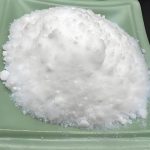Professional solutions on concrete addtives, Concrete Foaming Agent, Superplasticizer, CLC Blocks Additives, and foaming machine
PRODUCT PARAMETERS
Description
Overview of Silica Aerogel SiO2 Aerogel
Silica aerogel is a lightweight solid material composed of a three-dimensional framework of nanoscale colloidal particles. Its pore size is approximately one million times smaller than that of a steamed bun, and the framework particle size is reduced by a factor of 1,000, forming a smoky porous structure with a porosity ranging from 80% to 99.8%.
Data of Silica Aerogel Powder
| Items | Specification | ||
| Product Model | TR-W05 | TR-W20 | TR-W50 |
| Particle size(D50), um | 5 | 20 | 50 |
| Appearance | White Powder | ||
| Thermal conductivity,W/(m.k) | 0.017-0.023 | ||
| Application temperature,℃ | -200-800 | ||
| Specific surface area,m2/g | 400-700 | ||
| Pore size, nm | 15 | ||
| Bulk density,g/cm3 | 0.06-0.12 | ||
| Porosity,% | >90% | ||

silica aerogel
Applications of Silica Aerogel Powder
1) Thermal insulation
A typical application of silica gel is thermal insulation. Silica aerogel has a thermal conductivity of less than 0.02 W/(m・k), which is even lower than that of air. Silica aerogel is currently the best thermal insulation material available, suitable for applications in defence, industry, and research, particularly in maritime and aerospace fields. Additionally, it can be used in pipeline insulation, refrigerator insulation, clothing insulation, and insulated glass.
2) Catalyst Support and Catalyst
As research and development of silica gel continues, the thermal conductivity of silica aerogel can be continuously improved, and its strength enhanced, ensuring its applicability in catalyst carriers and catalysts. For example, the organic fusion of SiO₂ and TO₂ or the co-hydrolysis of Si and T metal alcoholates can produce TO₂-SiO₂ aerogel. This effectively enhances the adsorption performance and specific surface area of silica aerogel.
3) Acoustic Delay
Due to the unique porous nanostructure of silica gel, sound can propagate within its pores, resulting in significant energy loss, which reduces sound wave amplitude and slows down sound velocity. Additionally, aerogels exhibit low propagation rates and high acoustic impedance in solid materials. Silica aerogels prepared based on this principle possess advantages such as corrosion resistance, ageing resistance, and high-temperature resistance. Currently, silica aerogel can be applied in ultrasonic detectors, acoustic instruments, and soundproof windows.
4) Integrated Circuits
The key factor affecting operating speed is the substrate material of integrated circuits. Alumina ceramics are currently used as substrate materials, which have a high dielectric constant. Research has attempted to replace these substrate materials with polymer materials, but this can lead to thermal stress. Silica aerogel has a relatively low dielectric constant, a high breakdown voltage, a thermal expansion coefficient close to that of silicon, and good thermal stability, making it suitable for use in integrated circuits. This can reduce energy consumption, crosstalk, and interconnect delay, potentially tripling operational efficiency. However, current challenges include effectively addressing issues such as membrane cracking, leakage current, and absorptive properties.
Storage of Silica Aerogel Powder:
Keep packaging sealed and store in a dry, well-ventilated place. Do not store with other volatile chemicals to prevent the aerogel from absorbing these substances.

Company Profile
Cabr-Concrete is the global leader in Low-Density Cellular Concrete (LDCC), Celluar Light Concrete (CLC), and advanced engineered foam solutions. Known globally for its commitment to research, innovation, and applied expertise, we have been providing engineered foam solutions since the early 2012’s.
We can supply Silica Aerogel Powder over the world. The company has a professional technical department and quality supervision department, a well-equipped laboratory, and equipped with advanced testing equipment and after-sales customer service center.Send us an email or click on the needed products to send an inquiry.
If you want to know more about Silica Aerogel Powder, please feel free and contact us: sales@cabr-concrete.com

Payment
T/T, Western Union, Paypal, Credit Card etc.
Shipment
By air, by sea, by express, as customers request.
FAQ: Silica Aerogel
1. What is Silica Aerogel?
Silica aerogel is a synthetic porous ultralight material derived from silica-based gels, where the liquid component of the gel has been replaced with gas. It is often called “frozen smoke” due to its translucent appearance and low density. It is one of the lightest solid materials known.
2. What Are the Key Properties of Silica Aerogel?
- Ultra-low density: As low as 0.001 g/cm³.
- High porosity: Up to 99.8% air-filled pores.
- Excellent thermal insulation: Among the best thermal insulators with thermal conductivity as low as 0.013 W/m·K.
- High surface area: Up to 1000 m²/g.
- Transparency: Some forms are transparent to visible light.
- Tunable surface chemistry: Can be made hydrophobic or hydrophilic.
- Good acoustic and electrical insulation properties.
3. How Is Silica Aerogel Made?
The standard process involves:
- Sol-Gel Process:
- A silica source (e.g., TEOS – Tetraethyl Orthosilicate) is hydrolyzed and condensed to form a wet gel.
- Aging:
- The gel structure is strengthened over time.
- Drying:
- Supercritical drying (using CO₂) or ambient pressure drying removes the liquid without collapsing the structure.
4. What Are the Main Applications of Silica Aerogel?
- Thermal insulation: Used in aerospace, buildings, pipelines, and apparel.
- Catalyst support: Provides high surface area for chemical reactions.
- Adsorbent: For oil spill cleanup, gas separation, and environmental remediation.
- Optical devices: Used in Cherenkov detectors.
- Battery components: As electrode or separator materials.
- Protective clothing: Military and outdoor gear for thermal protection.
- Cultural heritage preservation: Insulation for historical structures.
5. Is Silica Aerogel Safe?
- Non-toxic: Made of silica (SiO₂), which is non-toxic.
- Respiratory irritant: Inhalation of fine particles may irritate lungs and airways.
- Skin irritation: Dry powder can be abrasive or drying.
- Safety recommendations: Wear gloves, mask, and eye protection when handling loose aerogel powder.





